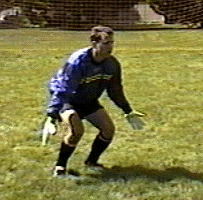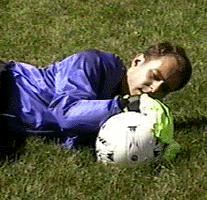The breakaway save requires all that a goalkeeper can muster - technique, timing, toughness, and courage. A successful save can turn the tide of a soccer game and lift the whole team, but it has to start with a solid technical foundation. Proper technique also serves to keep the goalkeeper from injury in what can be an extremely dangerous situation. There are three key components to a breakaway save: When the moment is right, start the slide. The goalkeeper should slide with their feet towards the center of the goal, with their body square to the attacker, and centered so the ball is around their lower chest or midsection. An attacker will be more likely (less afraid) to try to cut the ball to the hands/head side of the goalkeeper, so by sliding with the feet to the center of the goal an attacker who goes this way will go wide. Staying square provides the longest barrier possible; centering the ball provides equal barrier on either side. Do not allow the goalkeeper to slide feet first! Not only does this provide very little barrier to the attacker, but it exposes the whole lower part of the keeper's body to the attacker. After the save is made, the soccer ball should be securely held in front of the goalkeeper. The keeper should not roll over on or curl up around the ball, since this puts body parts between the ball and the attacker who is swinging at it! The ball is the keeper's shield in this case. Under Law 12, Decisions of the International FA Board, it states "The goalkeeper is considered to be in control of the ball by touching it with any part of his hand or arms." The referee should be reminded of this if they allow an attacker to kick at the ball after the goalkeeper has their hands on it. Finally, never give up on the ball, especially on a breakaway! Even if the goalkeeper does not smother the soccer ball completely on the slide, they will often deflect it, or at least push the attacker wide. If they can recover quickly, they may have given themselves
To start, approach the attacker in a slightly modified, lower ready position with the hands close to the ground (Fig. 1). The keeper needs to be close to the ready position because a shot could come at any moment, but modified because at close range the keeper is vulnerable to the quick, close shot right along the ground.
Fig. 1: Low Ready Position
Finally, smother the ball with the hands. In fact, throughout the slide the intent of the keeper should be to get their hands on the ball before the attacker can touch it again. Having the "hands first!" attitude will also help keep the slide from going feet first. If necessary, the keeper can use a modified catch involving the forearms to act as a shock absorber. The ball is caught with a bent wrist, between the palm and the forearm. The hands are hooked over the ball, in a sort of "cobra" position (Fig. 2). This position provides maximum protection, especially if the attacker is about to strike the ball.
Fig. 2: Modified "Cobra" Catching Position
Sunday, October 4, 2009
Breakaways
Posted by Syarif at 4:42 AM
Subscribe to:
Post Comments (Atom)
0 comments:
Post a Comment